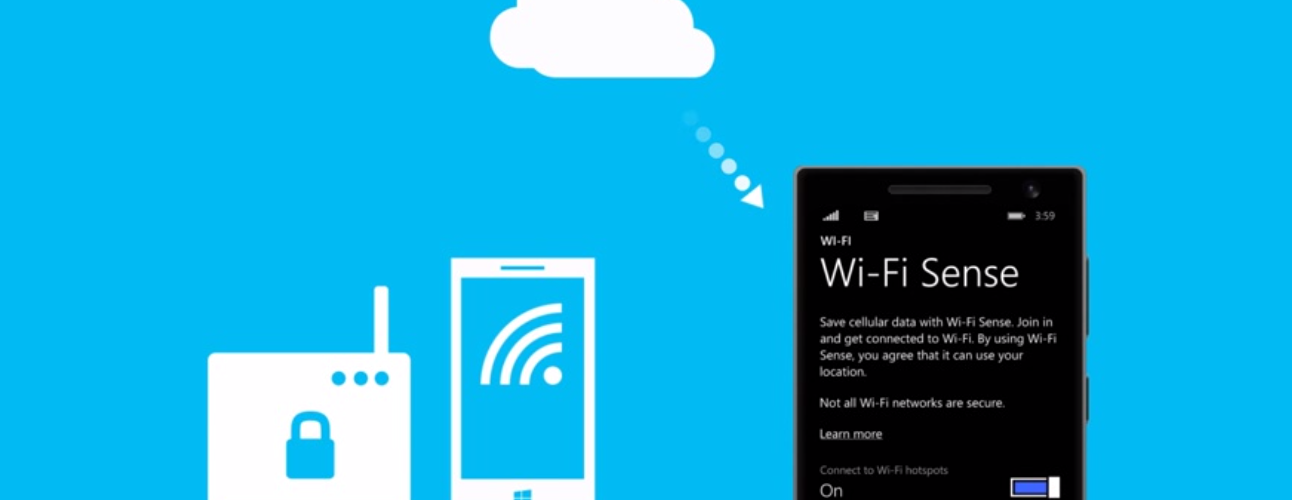It’s sad how many people don’t even know about this awesome feature that Window Phone 8.1 and Windows 10 users have. It’s one of the most useful features that Windows devices have if used properly. We made the ultimate guide for beginners on how to use Wi-Fi sense and a lot more information about it.
What’s Wi-Fi Sense?
First off, the most important and most frequently asked question: what is Wi-Fi Sense? Well, to put it shortly, it’s a sense your phone has for Wi-Fi networks. It discovers and shares Wi-Fi networks with your friends.
Do I have Wi-Fi Sense?
You probably do. Most phones with Windows Phone 8.1 or later (10) have it. Some countries or regions don’t support Wi-Fi Sense, and those are: Bangladesh, Brunei Darussalam, Indonesia, Singapore, Taiwan, and Thailand. So if you are from one of these countries, sorry – you don’t have Wi-Fi Sense. But any other phone with Windows 8.1 or Windows 10 Mobile will have it. Desktops and laptops with Windows 10 have Wi-Fi sense too. Desktops and laptops with Windows 8.1 or anything lower than 10 don’t have Wi-Fi sense.
Where is it?
For Windows Phone 8.1, the Wi-Fi Sense settings are located at Settings -> Wi-Fi -> Wi-Fi Sense.
For Windows 10 Mobile users: Settings -> Network & wireless -> Wi-Fi -> Wi-Fi Sense.
For Windows 10 Desktop users: Settings -> Network & Internet -> Manage Wi-Fi Settings.
At the Wi-Fi Sense settings page, you will find basic information and checkboxes for you to select or turn off/on.
How do I use it?
You’ll need to turn on Wi-Fi sense in the settings page.
If you want to connect to open hotspots (public networks) turn on Connect to suggested open hotspots. Open hotspots are the public networks that anyone can join without a password, but they usually require some basic information from you for you to be able to connect to it (like E-Mail, Name or Phone Number). Wi-Fi sense automatically shares information if it’s required for you to use the network, so you don’t have to manually input that through a browser. Turn on the Connect to networks shared by my contacts if you want to connect to Wi-Fi networks that your contacts have access to and chose to share them with you. In order for this to work it’s essential that some of your Facebook, Outlook or Skype friends have shared some Wi-Fi networks.
On Windows 8.1 and Windows 10 Phones you have to turn on your Location services in order to use Wi-Fi Sense. On Windows 10 Desktops you can leave your Location off, but you’ll have to leave Location for this device on.
On Windows 10 You have to share at least one of your Wi-Fi networks in order for you to receive other networks from your friends. On Windows Phone 8.1 you don’t have to share any networks to gain access to other networks.
How do I share Wi-Fi networks with my friends?
With Wi-Fi Sense you can share Wi-Fi networks with your Facebook, Outlook or Skype contacts. In order to share a Wi-Fi network, you will first, of course, need to have access to that network. When connecting to a network for the first time, check Share network with my contacts. And if you want to share a Wi-Fi network that you’re already connected to:
for Windows 10 Desktops: go to the Wi-Fi Sense settings page (Settings -> Network & Internet -> Wi-Fi -> Manage Wi-Fi Settings), scroll down to Manage known networks, select a network you would like to share and enter the password again in order to share it with your friends.
For Windows 10 Phones: go Settings -> Networks & Wireless -> Wi-Fi -> Manage then touch and hold or select the networks you would like to share and enter the password.
Those are the basic information you need to know about Wi-Fi sense and how to use it. Below, we will give you some more information about it and additional tutorials on how to change some settings for Wi-Fi Sense through some more frequently asked questions:
Can Wi-Fi Sense use my location if my location services are turned off?
On phones – no. If your Location services on your phone are turned off, Wi-Fi sense won’t use your location. On PCs – yes. You can have your Location services turned off on your Windows 10 Desktop and Wi-Fi Sense can still use your location. But if you turn off the Location for this device option, Wi-Fi Sense won’t be able to use your locations on your PC.
How do I choose what contacts I share my Wi-Fi with?
Go to the Wi-Fi Settings page and select groups of contacts you would like to share Wi-Fi networks with.
You can’t select individual people or contacts, you can just pick from the three groups of contacts (Outlook, Skype or Facebook contacts).
Can I share passwords using Wi-Fi Sense with Android/iOS users?
No. Wi-Fi Sense is exclusively available for Windows users. For mobile users – only Windows 8.1 or Windows 10. For desktop users – only Windows 10.
How long does it take for a network to be shared?
It can take a few days. After your contact shares a Wi-Fi network with you, it can take a few days until you can use it. It takes about the same amount of time when stopping a network share. After you stop sharing a network or after you remove a friend, it can take a few days for your friends to lose access to that network.
How do I stop sharing a network?
Top stop sharing a network with Wi-Fi Sense:
For Windows 10 PCs go to Settings -> Network & Internet -> Wi‑Fi -> Manage Wi‑Fi settings, scroll down to Manage known networks and select and stop the networks you would like to stop sharing.
For Windows 10 Phones go to Settings -> Network & wireless -> Wi‑Fi -> Manage, touch and hold the network and then select Stop sharing.
For Windows 8.1 Phones go to Settings -> Wi-Fi -> Manage and under Known Networks, touch and hold the network and then select Do not share.
How do I prohibit users from sharing my network?
The obvious thing to do is disable Wi-Fi Sense or disable sharing for that specific network. You also can add “_optout” (without the quotes) anywhere in your network’s name (SSID). For example, if your Wi-Fi is named “Apps4win_optout”, users won’t be able to share it through Wi-Fi Sense.
How secure is Wi-Fi Sense?
Wi-Fi Sense is actually a more secure way of sharing passwords with other people than through messaging, speaking or any other kind of information transport. The passwords you share through Wi-Fi Sense are transported and sent through a secure and encrypted HTTPS connection and stored on an encrypted file on a Microsoft server. Users don’t see the password when it’s shared through Wi-Fi Sense.
Your contacts can’t share your Wi-Fi password with their contacts. In order for your friend to share your password to another friend, he will have to type it in manually.
Networks that use 802.1X can’t be shared.
When connecting to a Wi-Fi if you don’t check the box for Share network with my contacts – they won’t be able to share the network unless they type in the password manually.
So if you are really afraid and cautious of who uses your network or if you don’t trust your friends – don’t use Wi-Fi Sense and add an “_optout” to your SSID.
Users connected through Wi-Fi Sense on a network won’t have access to other devices and files stored on that network.
In Windows Phone 8.1 for public hotspots you can provide generic information instead of your real e-mail, name or phone number by going to the Wi-Fi Settings page and then Edit info. Or you don’t have to provide any information at all via Wi-Fi Sense, you can do it all manually through a browser.
In conclusion, Wi-Fi Sense is a pretty useful and secure tool for sharing Wi-Fi passwords with your friends or connecting to public hotspots. This is an ultimate guide though and we tried to include every useful information we could find, using Wi-Fi Sense is not that complicated. Just go to the Wi-Fi Sense settings page and you will figure it out in no time. For more information, visit Microsoft’s Wi-Fi Sense page or leave a comment if you have any questions





